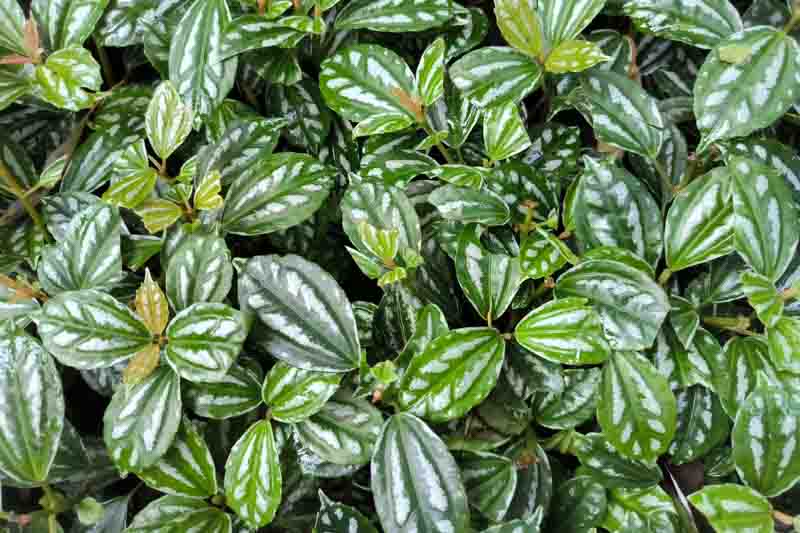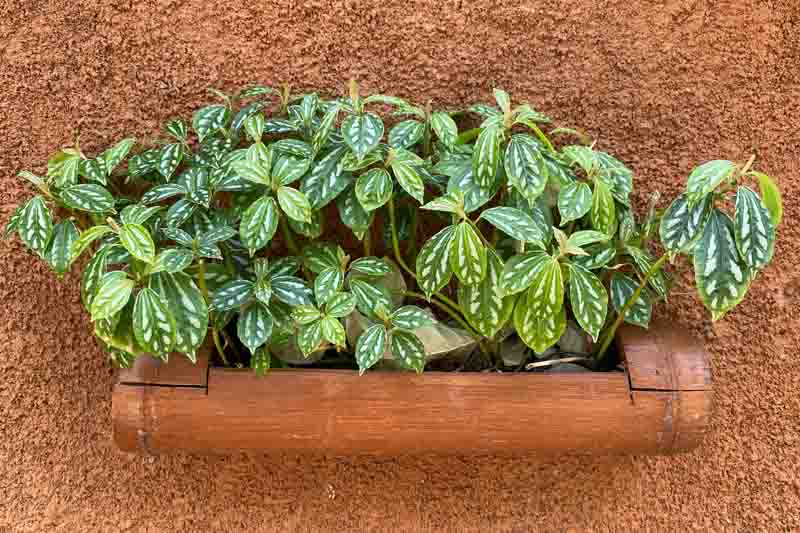Aluminum plant, Watermelon Pilea, Watermelon Plant
Pilea cadierei, commonly known as Aluminum Plant or Watermelon Pilea, is an attractive and popular houseplant due to its unique foliage and easy-care nature.
Pilea cadierei boasts striking oval green leaves with bright silver patterns that resemble the aluminum sheen, giving it its common name. The contrast of the metallic markings against the dark green backdrop makes it a visually appealing addition to any indoor plant collection.
Native: This plant is native to Vietnam and China. It grows in the understory of tropical forests, enjoying humid and shaded conditions. It belongs to the nettle family (Urticaceae) and is part of a diverse genus with over 600 species.
Plant Type and Habit: It is a bushy, evergreen perennial with a compact growth habit. It typically grows upright, but its stems can start to spread or droop as they lengthen, making it an excellent choice for hanging baskets or shelves.
Size: An Aluminum Plant usually reaches about 12 inches (30 cm) in height and spread, making it a suitable size for indoor cultivation on desks, tabletops, or as part of a mixed display.
Flowers: While Pilea cadierei does flower, its blooms are small, greenish, and not particularly showy. The main attraction is undoubtedly its foliage.
Foliage: The aluminum plant’s standout feature is its foliage, which features obovate leaves marked with silver patterns that add a splash of brightness to indoor spaces.
Hardiness: It is suited for USDA hardiness zones 11-12 if grown outdoors, but it is predominantly kept as an indoor plant due to its sensitivity to cold temperatures.
Award: Recipient of the prestigious Award of Garden Merit of the Royal Horticultural Society.
Uses: Pilea cadierei is primarily used as an ornamental indoor plant. Its compact size and unique foliage make it perfect for terrariums, tabletop displays, or as a part of a larger indoor garden. It’s also used in office spaces to add a touch of greenery.
Toxicity: Pilea cadierei is considered non-toxic to pets and humans, making it a safe addition to households with pets and children.
Benefits: Beyond its decorative appeal, it can improve indoor air quality by absorbing pollutants. Its presence can also enhance well-being by adding greenery to living spaces.

Growing and caring for the Aluminum Plant is relatively easy, making it a great choice for both novice and experienced gardeners.
Light: The Aluminum Plant prefers bright, indirect sunlight. Direct sunlight can scorch its leaves, while too little light can cause it to lose its vibrant patterns. A spot near an east or north-facing window is ideal.
Soil: Use a well-draining potting mix rich in organic matter. A standard houseplant or peat-based mix works well, ensuring proper drainage and aeration for the roots.
Water: Maintain consistently moist soil, but avoid waterlogging. Water when the top inch of soil feels dry to the touch. Reduce watering in the winter when the plant’s growth slows down.
Temperature and Humidity: Keep the plant in a warm environment, ideally between 60°F and 75°F (16°C to 24°C). Protect it from drafts and sudden temperature changes, which can stress the plant. Pilea cadierei thrives in high humidity, similar to its native tropical environment. Increase humidity around the plant by misting it regularly, placing it on a pebble tray filled with water, or using a humidifier.
Fertilization: Feed the Aluminum Plant with a half-strength, balanced liquid fertilizer once a month during the growing season (spring through summer). Do not fertilize in the fall and winter when the plant’s growth naturally slows.
Pruning: Pruning is not typically necessary, but you can trim back any leggy or overgrown stems to maintain a compact, bushy appearance. This will also encourage fuller growth.
Repotting: Repot your Aluminum Plant every 1-2 years or when it becomes root-bound. Choose a pot that is slightly larger than the current one to allow for continued growth. Repotting is also a good opportunity to refresh the soil.
Propagating the Aluminum Plant is straightforward and can be an enjoyable way to expand your collection or share with friends. Here’s a simple guide on how to propagate through stem cuttings:
Select a Healthy Stem: Look for healthy, mature stems on your Aluminum Plant that have at least 2-3 leaves. Avoid stems that are too young or show any signs of damage or disease.
Cut the Stem: Using your clean, sharp scissors or pruning shears, cut a 4-6 inch piece from the selected stem. Make sure your cutting includes at least one leaf node (the point on the stem where leaves emerge), as roots will develop from these nodes.
Prepare the Cutting: Remove the leaves from the bottom half of the cutting to expose the nodes. If you’re using rooting hormone, now is the time to dip the cut end of the stem into it. This step is optional but can help stimulate root growth.
Plant the Cutting: Fill your small pot with well-draining potting mix and make a hole in the center with your finger or a pencil. Insert the cut end of the stem into the hole, ensuring at least one node is buried beneath the soil surface. Gently firm the soil around the stem to support it.
Create Humidity: To keep the humidity high around your cutting, you can cover the pot with a clear plastic bag or place it under a propagation dome. Ensure there are a few holes for ventilation and that the plastic does not touch the leaves.
Place in Indirect Light: Position your potted cutting in a warm spot with bright, indirect light. Avoid direct sunlight, which can be too intense for the young cutting.
Care During Rooting: Keep the soil consistently moist but not waterlogged. Check the cutting regularly for root development, which typically begins within a few weeks.
Transplanting: Once the cutting has established a strong root system and begins to show new growth, you can gradually acclimate it to typical Aluminum Plant care conditions.

The Aluminum Plant is generally easy to care for, but like all plants, it can encounter pests, diseases, and common problems.
Spider Mites: These tiny pests can be identified by the fine webs they weave on the plant. They cause yellowing or speckled leaves. Increase humidity around the plant and wash it with a strong stream of water. For severe infestations, use insecticidal soap or neem oil.
Mealybugs: These white, cottony pests tend to cluster in leaf axils and under leaves, sucking sap and weakening the plant. Remove with alcohol-dipped cotton swabs or apply neem oil.
Scale insects: Hard or soft-bodied insects that attach themselves to the stems or leaves, causing yellowing and growth stunting. Scrape off with a fingernail or use a cotton swab dipped in rubbing alcohol. Insecticidal soap or neem oil may also be used.
Aphids: These small, green pests suck sap from new growth. Rinse them off with water or treat the plant with neem oil.
Root rot: This is a common issue caused by overwatering or poor drainage. Symptoms include yellowing leaves, wilting, and a mushy stem base. Prevent root rot by ensuring the pot has good drainage and by letting the top inch of soil dry out between waterings. If root rot is detected, you may need to remove the plant from its pot, trim away the rotten roots, and repot it in fresh, well-draining soil.
Powdery mildew: Might affect the leaves in high humidity with poor air circulation, appearing as white powdery spots. Improve air circulation and treat with fungicide if necessary.
Leaf Drop can occur if the Aluminum Plant is exposed to drafty windows, sudden temperature changes, or if it’s underwatered. Ensure consistent care and protect the plant from cold drafts.
Leaf Scorching is the result of too much direct sunlight. The Aluminum Plant prefers bright, indirect light. If leaves become scorched, move the plant to a location where it will receive filtered light.
Leggy Growth happens when the plant is not receiving enough light, causing it to stretch towards the light source. Ensure the plant is placed in a location where it receives adequate indirect sunlight.

The Aluminum Plant (Pilea cadierei) thrives in bright, indirect sunlight. It can tolerate some direct morning light but should be protected from intense, direct afternoon sunlight, which can scorch its leaves. A location near a window with a sheer curtain is often ideal to filter the light.
Yes, the Aluminum Plant is commonly grown as an indoor plant. Its preference for warm temperatures, indirect sunlight, and high humidity levels makes it well-suited to indoor environments. While it can be grown outdoors in tropical or subtropical climates, in most regions, it’s enjoyed as a houseplant.
The Aluminum Plant is considered non-toxic to cats and dogs. However, it’s always a good practice to keep houseplants out of reach of pets to avoid any potential issues, such as stomach upset from ingesting plant material or damage to the plant.
Water your Aluminum Plant when the top inch of the soil feels dry to the touch. It prefers consistently moist soil but does not like to sit in water. Ensure good drainage to prevent root rot. During the growing season (spring and summer), you may need to water more frequently. Reduce watering in the fall and winter when the plant’s growth slows down. The frequency of watering will also depend on the humidity and temperature of your home, as well as the plant’s exposure to light. Always check the soil moisture level before watering.
| Hardiness |
11 - 12 |
|---|---|
| Plant Type | Houseplants, Perennials |
| Plant Family | Urticaceae |
| Genus | Pilea |
| Exposure | Partial Sun |
| Season of Interest |
Spring (Early, Mid, Late) Summer (Early, Mid, Late) Fall Winter |
| Height |
9" - 1' (23cm - 30cm) |
| Spread |
6" - 1' (15cm - 30cm) |
| Maintenance | Low |
| Water Needs | Average |
| Soil Type | Loam |
| Soil pH | Acid, Neutral, Alkaline |
| Soil Drainage | Moist but Well-Drained |
| Characteristics | Showy, Evergreen, Plant of Merit |
| Garden Uses | Hanging Baskets, Patio And Containers |
| Hardiness |
11 - 12 |
|---|---|
| Plant Type | Houseplants, Perennials |
| Plant Family | Urticaceae |
| Genus | Pilea |
| Exposure | Partial Sun |
| Season of Interest |
Spring (Early, Mid, Late) Summer (Early, Mid, Late) Fall Winter |
| Height |
9" - 1' (23cm - 30cm) |
| Spread |
6" - 1' (15cm - 30cm) |
| Maintenance | Low |
| Water Needs | Average |
| Soil Type | Loam |
| Soil pH | Acid, Neutral, Alkaline |
| Soil Drainage | Moist but Well-Drained |
| Characteristics | Showy, Evergreen, Plant of Merit |
| Garden Uses | Hanging Baskets, Patio And Containers |
How many Pilea cadierei (Aluminum Plant) do I need for my garden?
| Plant | Quantity | |
|---|---|---|
| Pilea cadierei (Aluminum Plant) | N/A | Buy Plants |
Create a membership account to save your garden designs and to view them on any device.
Becoming a contributing member of Gardenia is easy and can be done in just a few minutes. If you provide us with your name, email address and the payment of a modest $25 annual membership fee, you will become a full member, enabling you to design and save up to 25 of your garden design ideas.
Join now and start creating your dream garden!
Create a membership account to save your garden designs and to view them on any device.
Becoming a contributing member of Gardenia is easy and can be done in just a few minutes. If you provide us with your name, email address and the payment of a modest $25 annual membership fee, you will become a full member, enabling you to design and save up to 25 of your garden design ideas.
Join now and start creating your dream garden!